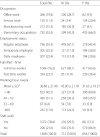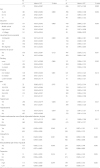1. The Korean Society for Preventive Medicine. Preventive medicine and public health. 2/e ed. 2013. Korea: Gyechuk.
2. Korean statistical information service: 2000 Census.
http://kosis.kr (2000). Accessed: 20 Jan 2015.
3. Statistics Korea. Population projections for Korea : 2010 ~ 2060 (Based on the 2010 Census). Daejeon: Statistics Korea; 2011.
4. Choi DW. Accident characteristics and safety measures for aging workers in Korea [master's thesis]. 2013. Seoul: Seoul National University of Science and Technology;p. 106.
5. Kim YS, Kim BH, Kim HM. A study on occupational accident of older workers and vulnerable working condition. Health Soc Sci. 2014; 35:309–329.
6. Lee JC, Shin SW, Lee CS. Accident analysis of middle-aged & advanced-aged construction workers. J Archit Inst Korea. 2007; 27(1):797–800.
7. Park SY. Risk factors for occupational injuries: a comparison of older and younger workers in Korea [master's thesis]. 2009. Seoul: Catholic university of Korea;p. 31.
8. Lee JJ, Lee HJ, Park EJ. Effect of staged education program for hypertension, diabetes patients in a community (assessment of quality of life using EQ-5D). J Agric Med Commun Health. 2014; 39(1):37–45. DOI:
10.5393/JAMCH.2014.39.1.037.
9. Jo MW, Kim SK, Lee JY, Lee KS. Estimating quality adjusted life year loss of persons disabled by stroke using EQ-5D in Korea. J Agric Med Commun Health. 2011; 36(2):120–129. DOI:
10.5393/JAMCH.2011.36.2.120.
10. Shin S. A study on health related quality of life in people living with HIV/AIDS in Korea. Health Welf Rev. 2011; 31(4):424–453. DOI:
10.15709/hswr.2011.31.4.424.
11. Oh KA, Park J, Jeon DJ, Han MA, Choi SW. Relationship between low back pain and health-related quality of life among some elderly. J Agric Med Commun Health. 2012; 37(3):156–166. DOI:
10.5393/JAMCH.2012.37.3.156.
12. Kim JG, Kwon LS. Measurement of quality of life related to health by demographic characteristics of adult patients with cancer using EQ-5D index -focused on the Korea health & nutrition examination survey. J Digit Convergence. 2013; 11(8):281–291.
13. Lee SH. Gender difference in influencing factors on health related quality of life among the elderly in community. J Digit Convergence. 2013; 11(12):523–535. DOI:
10.14400/JDPM.2013.11.12.523.
14. Kim JY. Factors affecting health related quality of life among aged [master's thesis]. 2014. Kimhae: Inje University;p. 54.
15. Shin KR, Byeon YS, Kang Y, Oak J. A study on physical symptom, activity of daily living, and health-related quality of life (HRQoL) in the community-dwelling older adults. Taehan Kanho Hakhoe Chi. 2008; 38(3):437–444. PMID:
18604153.
16. Kim Y. Factors influencing the health-related quality of life by age among vulnerable elderly women. J Korea Acad-Ind Soc. 2013; 14(3):1342–1349.
17. Lee JH, Yoon BJ, Jeong H-S. Decomposition of the health concentration index by health dimensions applied on EQ‐5D. Health Soc Sci. 2009; 26:67–87.
18. Choi H, Lee E-O, Kim B-W, Kim I-J. Stage of change for exercise and health-related quality of life in Korean adults. Korean J Adult Nurs. 2004; 16(2):191–201.
19. Taylor WJ, Myers J, Simpson RT, McPherson KM, Weatherall M. Quality of life of people with rheumatoid arthritis as measured by the World Health Organization Quality of Life Instrument, short form (WHOQOL-BREF): score distributions and psychometric properties. Arthritis Rheum. 2004; 51(3):350–357. DOI:
10.1002/art.20398. PMID:
15188318.
20. The WHOQOL Group. The World Health Organization Quality of Life assessment (WHOQOL): position paper from the World Health Organization. Soc Sci Med. 1995; 41(10):1403–9. DOI:
10.1016/0277-9536(95)00112-K. PMID:
8560308.
21. Spiker B, Revicki DA. Spiker B, editor. Quality of life and pharmacoeconomics in clinical trials. Taxonomy of quality of life. 1996. 2. Philadelphia: Lippincott-Raven Publishers;p. 25–31.
22. Kaplan RM, Ganiats TG, Sieber WJ. The Quality of Well-Being Scale - Self Administered (QWB-SA). 1996.
https://hoap.ucsd.edu/qwb-info. Accessed: 3 Jan 2015.
23. Torrance GW, Feeny DH, Furlong WJ, Barr RD, Zhang Y, Wang Q. Multiattribute utility function for a comprehensive health status classification system. Health utilities index mark 2. Med Care. 1996; 34(7):702–722. DOI:
10.1097/00005650-199607000-00004. PMID:
8676608.
24. Feeny D, Furlong W, Torrance GW, Goldsmith CH, Zhu Z, DePauw S, et al. Multiattribute and single-attribute utility functions for the health utilities index mark 3 system. Med Care. 2002; 40(2):113–128. DOI:
10.1097/00005650-200202000-00006. PMID:
11802084.
26. Brazier JE, Fukuhara S, Roberts J, Kharroubi S, Yamamoto Y, Ikeda S, et al. Estimating a preference-based index from the Japanese SF-36. J Clin Epidemiol. 2009; 62(12):1323–1331. DOI:
10.1016/j.jclinepi.2009.01.022. PMID:
19615856.
27. Nam HS, Kim KY, Kwon SS, Koh KW, Kind P. EQ-5D Korean valuation study using time trade off method. 2007. Seoul: Korea Centers for Disease Control and Prevention.
28. Economically Active Population survey. Statistics Korea. 2013.
http://kosis.kr. Accessed: 3 Jan 2015.
29. Ryu JY. A Study on the ways of activating elderly labor forces in the aging society [master's thesis]. 2005. Seongnam: Kyoungwon University;p. 135.
30. Lee S-l. Labor force shortage projection and policy implications : impact of demographic transition in Korea. Korea J Popul. 2012; 35(2):1–28.
31. Kim KH. Comparison of health-related quality of life by occupational status using EQ-5D index [master's thesis]. 2010. Seoul: Catholic University of Korea;p. 34.
33. Luo N, Johnson JA, Shaw JW, Feeny D, Coons SJ. Self-reported health status of the general adult U.S. Population as assessed by the EQ-5D and health utilities index. Med Care. 2005; 43(11):1078–1086. DOI:
10.1097/01.mlr.0000182493.57090.c1. PMID:
16224300.
34. Wang HM, Patrick DL, Edwards TC, Skalicky AM, Zeng HY, Gu WW. Validation of the EQ-5D in a general population sample in urban China. Qual Life Res. 2012; 21(1):155–160. DOI:
10.1007/s11136-011-9915-6. PMID:
21505881.
35. Dembe AE, Erickson JB, Delbos RG, Banks SM. The impact of overtime and long work hours on occupational injuries and illnesses: new evidence from the United States. Occup Environ Med. 2005; 62(9):588–597. DOI:
10.1136/oem.2004.016667. PMID:
16109814.
36. Iwasaki K, Sasaki T, Oka T, Hisanaga N. Effect of working hours on biological functions related to cardiovascular system among salesmen in a machinery manufacturing company. Ind Health. 1998; 36(4):361–367. DOI:
10.2486/indhealth.36.361. PMID:
9810150.
37. Jeong I, Rhie J, Kim I, Ryu I, Jung PK, Park YS, et al. Working hours and cardiovascular disease in Korean workers: a case-control study. J Occup Health. 2014; 55(5):385–391. DOI:
10.1539/joh.12-0245-OA. PMID:
23995985.
38. Choi B, Schnall PL, Dobson M, Garcia-Rivas J, Kim H, Zaldivar F, et al. Very long (>48 hours) shifts and cardiovascular strain in firefighters: a theoretical framework. Ann Occup Environ Med. 2014; 26(1):5. DOI:
10.1186/2052-4374-26-5. PMID:
24602344.
39. Virtanen M, Ferrie JE, Gimeno D, Vahtera J, Elovainio M, Singh-Manoux A, et al. Long working hours and sleep disturbances: the Whitehall II prospective cohort study. Sleep. 2009; 32(6):737–745. PMID:
19544749.
40. Kleppa E, Sanne B, Tell GS. Working overtime is associated with anxiety and depression: the hordaland health study. J Occup Environ Med. 2008; 50(6):658–666. DOI:
10.1097/JOM.0b013e3181734330. PMID:
18545093.











 PDF
PDF Citation
Citation Print
Print


 XML Download
XML Download